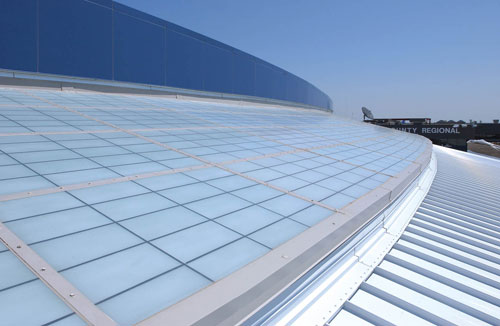Fiberglass Reinforced Plastic: High Performance in Ceiling and Wall Panels
FRP versus Other Materials
FRP compares favorably to other materials in a number of respects:
Ceramic tile. Tile must be cleaned at a greater frequency than FRP panels. With tile, dirt, mildew and staining in the grout lines are common. Tiles can also crack and shatter and can be difficult to replace. Usually ceramic tiles cost twice as much as FRP materials.
Stainless steel. This material dents easily upon impact and its surface shows any abrasion marks. Stainless steel is susceptible to corrosion in certain environments and can be twice the price of FRP.
Drywall. Difficult to clean and requiring frequent repainting, drywall also has a relatively low impact strength compared to FRP. In addition, drywall has poor resistance to water and moisture and is therefore susceptible to mold and mildew.
Photo: Crane Composites, Inc.
Drywall is difficult to clean.
Concrete block. Concrete block is porous and must therefore be sealed or painted often. It is difficult to clean and is not USDA-compliant.
Epoxy paint. Epoxy paint involves a labor intensive installation process and after installation it has high maintenance requirements. Epoxy paint is not impact or abrasion resistant and it is easily affected by moisture and chemicals.
Vinyl wall coverings.Vinyl wall coverings are expensive and difficult to install. They are not impact or abrasion resistant and tend to show imperfections below the surface.
Specification Considerations
Architects should consider the following parameters when specifying FRP ceiling and wall panels:
Thickness. A standard FRP textured panel is .09 inches thick
Weight. A standard FRP panel generally weighs .7lb/per square foot
Flame and smoke rating. Like other organic building materials (e.g., wood), products made of FRP resins will burn. When ignited, FRP may produce dense smoke very rapidly. All smoke is toxic. Fire safety requires proper design of facilities and fire suppression systems, as well as precautions during construction and occupancy. Local codes, insurance companies and any special needs of the product user will determine the correct fire-rated interior finish and fire suppression system necessary for a specific installation.
FRP can be modified with additives to meet the code requirements of the particular application. One common testing method for building materials is the ASTM-E84 "Tunnel Test" in which the flammability and smoke development are measured and indexed against the performance of Red Oak in the same test. ASTM E-84 is the standard test method for surface burning characteristics of building materials and applicable to exposed surfaces for ceilings and walls. Class A ratings indicate a flame spread of 25 or less, and a smoke density of 450 or less. Less stringent Class C ratings indicate a flame spread between 76 and 200, and smoke development of 450 or less. It's important to note, however, that numerical flame spread and smoke development ratings are not intended to reflect hazards presented by FRP products or any other material under actual fire conditions. These ratings are determined by small-scale tests conducted by Underwriters Laboratories and other independent testing facilities using the American Society for Testing and Materials E-84 test standard. These ratings should be used for material comparison purposes only.
Factory Mutual approved FRP panels pass a more stringent fire test than the standard ASTM E-84 requirements. For strictest fire standards, architects should look for FRP panels with an FM-approved test report "#2B2A2.AM," as opposed to the ASTM E-84 reports.
Resistance to abrasion. Resistance to abrasion is defined as the ability of a material to withstand mechanical action such as rubbing, scraping, or erosion. Abrasion can be difficult to compare but haze variation or weight loss are often evaluated. For FRP wall or ceiling panels the measurement is the Taber Abrasion Resistance test.
Special codes. Architects should note that FRP panels to be used in food processing environments should meet the requirements of the Food Service Inspection Service of the U.S. Department of Agriculture. Other codes that may have bearing on an FRP installation would include the New York City Materials and Equipment Acceptance code, the City of Los Angeles codes and the International Codes, or I-Codes, published by ICC, that provide minimum safeguards for people at home, at school and in the workplace. The I-Codes are a complete
set of comprehensive, coordinated building safety and fire prevention codes. Building codes benefit public safety and support the industry's need for one set of codes without regional limitations. Fifty states and the District of Columbia have adopted the I-Codes at the state or jurisdictional level.
Daylighting Panels |
 |
Photo: Major Industries |
FRP panels using an advanced polymer resin system with UV inhibitors and color stabilizers can offer good weathering performance in curtain wall, metal building |
Environmental Considerations
Architects interested in specifying products that are as environmentally sound as possible should look to how manufacturers approach waste reduction and recycling. Manufacturers of FRP panels can implement production efficiencies and reduction in reject that can reduce land fill waste substantially. One manufacturer produced 9.7 million or 36 percent less square feet of scrap, that would have been sent to the landfill. This substantial reduction was accomplished by narrowing the amount of edge trim inherent in the process, developing quicker changeovers between production runs, reducing reject caused by material thickness tolerance variances, and demanding consistent raw material quality from vendors. A method known as Single Minute Exchange of Die (SMED), a lean production method, also reduces waste in a manufacturing process by providing a rapid and efficient way of converting a manufacturing process from running the current product to running the next product.
Manufacturers can also slate material that does not meet first pass yield quality inspection to be reworked into smaller sizes or alternate application uses. In addition, manufacturers can participate in programs for landfill avoidance - programs that promote waste prevention, recycling or composting.










